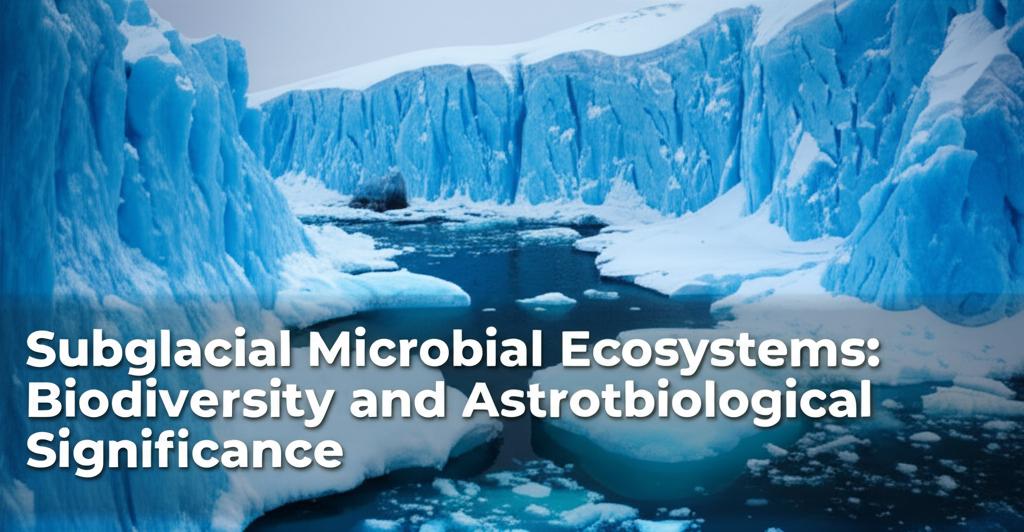Vast and frigid, the undersides of Earth's glaciers and ice sheets were once considered barren. However, scientific exploration has revealed that these subglacial environments are teeming with diverse microbial ecosystems. These hidden biomes, existing in perpetual darkness, under immense pressure, and with limited nutrients, are not only revolutionizing our understanding of where life can exist on our planet but also hold profound implications for the search for life beyond Earth.
A World Beneath the Ice: Unveiling Microbial DiversitySubglacial environments, which include lakes and saturated sediments beneath glaciers and ice sheets, cover a significant portion of Earth's land surface. Despite the extreme conditions – constant cold, no sunlight for photosynthesis, high pressure, and limited nutrient and energy availability – a remarkable array of microorganisms thrives. These are not just isolated pockets of life; evidence suggests that interconnected systems of waterways may exist beneath large ice sheets like Antarctica, potentially allowing for the transfer of microbes, carbon, and nutrients between subglacial lakes.
Recent research highlights the presence of active and diverse microbial communities. For instance, studies in Antarctica have uncovered ecosystems in subglacial lakes, isolated for potentially millions of years, containing microbes that have evolved unique adaptations. Some of these organisms are chemolithoautotrophs, meaning they derive energy from inorganic chemical reactions, such as the oxidation of iron or sulfur compounds, rather than sunlight. The grinding of bedrock by glaciers can expose fresh mineral surfaces, providing the chemical ingredients necessary to sustain this microbial metabolism. Hydrogen produced by this rock comminution has also been identified as a key energy source for some subglacial microbial communities.
In a particularly striking discovery reported in May 2025, researchers drilling into Lake Vostok, a massive subglacial lake in Antarctica, found microbial life forms that do not align with any known species or genetic sequences. Preliminary analyses suggest these organisms might represent a completely new biological lineage, having adapted to the extreme pressure, low oxygen, and freezing conditions of their isolated environment over vast timescales.
Arctic regions also host these unique ecosystems. Studies in Svalbard have revealed that areas where methane and carbon dioxide seep from beneath the permafrost create energy-rich environments supporting diverse microbial life, even within the ice itself. These chemolithoautotrophic bacteria thrive in the dark, cold, and nutrient-poor conditions by utilizing inorganic compounds for energy.
Adapting to the ExtremesLife in subglacial environments requires extraordinary adaptations. Microorganisms in these habitats must cope with:
- Low Temperatures: Many are psychrophiles or psychrotolerant, possessing enzymes and cell membranes that function optimally in cold conditions. Some may even metabolize within the thin veins of liquid water present between ice grains at temperatures well below freezing.
- High Pressure: The immense weight of overlying ice creates high-pressure conditions that necessitate specialized cellular structures and processes.
- Limited Nutrients and Energy: In the absence of sunlight, microbes rely on chemosynthesis, utilizing minerals from the underlying bedrock or dissolved gases. Some ecosystems show very slow growth rates, with cell division potentially taking a year or more.
- Isolation: Some subglacial lakes have been cut off from the atmosphere and the rest of the biosphere for millions of years, creating natural laboratories for studying evolutionary processes in extreme isolation.
- Osmotic Stress: The processes of freezing and thawing can create osmotic imbalances, and microbes have developed strategies like producing compatible solutes to protect their cells.
The discovery and ongoing study of subglacial microbial ecosystems on Earth have profound implications for astrobiology – the search for life beyond our planet. Many celestial bodies in our solar system are icy worlds, possessing thick ice shells overlying liquid water oceans or lakes.
- Europa and Enceladus: Jupiter's moon Europa and Saturn's moon Enceladus are prime targets in the search for extraterrestrial life. Both are believed to harbor vast subsurface oceans beneath their icy crusts. The conditions in these oceans – cold, dark, potentially rich in dissolved minerals from interactions with a rocky core, and under significant pressure – bear a striking resemblance to Earth's subglacial lakes. The existence of thriving microbial ecosystems in analogous environments on Earth significantly strengthens the hypothesis that life could arise and persist on these icy moons. Recent findings of carbon dioxide on Europa’s surface, likely originating from its subglacial ocean, further fuel this excitement, as carbon is a key building block for life as we know it.
- Mars: Evidence suggests that Mars may have liquid water trapped beneath its polar ice caps and may have harbored glaciers at lower latitudes in the past. Subglacial environments on Earth serve as important analogs for understanding if microbial life could exist, or have existed, in similar niches on Mars.
- Testing Technologies: Studying subglacial environments on Earth also provides an invaluable testing ground for technologies and methodologies that could one day be used to explore these distant icy worlds. Developing clean drilling techniques to access subglacial lakes without contaminating them is directly relevant to future missions aiming to sample subsurface oceans on moons like Europa.
The resilience and adaptability of life found deep beneath Earth's ice sheets offer compelling evidence that the "habitable zone" for life is far broader than previously imagined. These unique ecosystems are not just a testament to the tenacity of life on our own planet but also provide crucial insights and hope in the ongoing quest to determine if we are alone in the universe. Future research, including upcoming missions like NASA's Europa Clipper and ESA's JUICE, will continue to build on our understanding of these extreme environments and their potential to harbor life, both on Earth and beyond.
However, these unique ecosystems are also under threat. Climate change is causing glaciers worldwide to recede at an alarming rate. As glaciers melt, these previously isolated subglacial environments are being exposed, and the unique microbial communities adapted to these extreme conditions may disappear, potentially impacting downstream ecosystems and biogeochemical cycles. This highlights the urgent need to study and understand these fragile environments before they are irrevocably altered.

